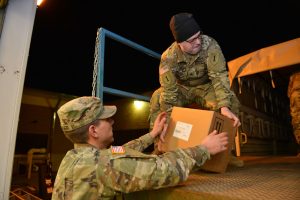It’s no secret that there is a crisis in the Midwest, mainly focused in Nebraska, South Dakota, and Wisconsin. As flood waters recede and the damage is slowly revealed (current estimates have it approaching $1 billion in Nebraska alone), the question turns from how to prevent the inevitable damage to how to deal with the aftermath.
The flood had many factors that contributed to its severity: heavy rainfall, accumulated snow melting, and frozen ground are the big three. The term “bomb cyclone” was used repeatedly in the media. Ultimately, nothing could be done to avoid the disaster.
Now, fields are washed away, livestock are gone or injured, and equipment and structures are damaged. Not to mention those who lost their lives to the disaster.
In one image from Nebraska (used as the main image on this article), National Guard troops provide relief to a fifth-generation farm family whose farm was so devastated by the floods, you can barely tell there was ever farm land there to begin with. In that state, nearly 70 percent of counties are under emergency declarations.
So, how do we, as an agricultural community, come together in this time of need?
The Nebraska Department of Agriculture has an extensive list of places that will take any and all help that is given. Help can be in the form of money, fencing, livestock feed, veterinary supplies, medical supplies, toiletries, cleaning supplies, or any other needed resource.
One of the biggest needs right now is relief funding. There are several individual foundations being utilized, including Nebraska Cattlemen Disaster Relief Fund and the Nebraska Farm Bureau Foundation.
- The Nebraska Cattlemen Disaster Relief Fund is a service of Nebraska Cattlemen that provides market reporting, communication, promotion, and legislation promotion. All donations they receive for disaster relief will go directly to the cause.
- The Nebraska Farm Bureau Foundation has a monetary donation section and an exchange for agricultural commodities. If you, or someone you know, has more hay than needed or spare equipment lying around, go to the website and let them know.
And there are certainly more.
- Farm Rescue, which has had its Operation Hay Lift in place for a couple of years, is asking for volunteers and hay donations to take to flood-stricken Nebraska ranchers.
- Out of Florence, Texas, a volunteer is lined up to haul feed to Nebraska. They have have begun accepting donations — call Andrea Daniell, 512-635-5539.
- The Nebraska FFA Foundation has established a Storm Relief Fund for FFA supporters to provide resources to Nebraska FFA members and chapters — 100 percent of the donations through Nebraska FFA will be distributed to members and chapters that were affected by the floods and blizzards.
- Ohio’s Rural America Relief is collecting relief supplies and plans to transport them to the crisis areas from March 29 to April 1. Their Facebook page is posting drop-off points.
- For some of the more mainstream donation avenues, such as the American Red Cross and Salvation Army, donation information can be found here.
When tragedy strikes the American farmer, they are not down for long. As a community with the same values of resiliency, care for the land, and a dedication to hard work, agriculture will come back from this; just like any other event that was equally disastrous or worse.
Do your part, if you can, to help those in need.



